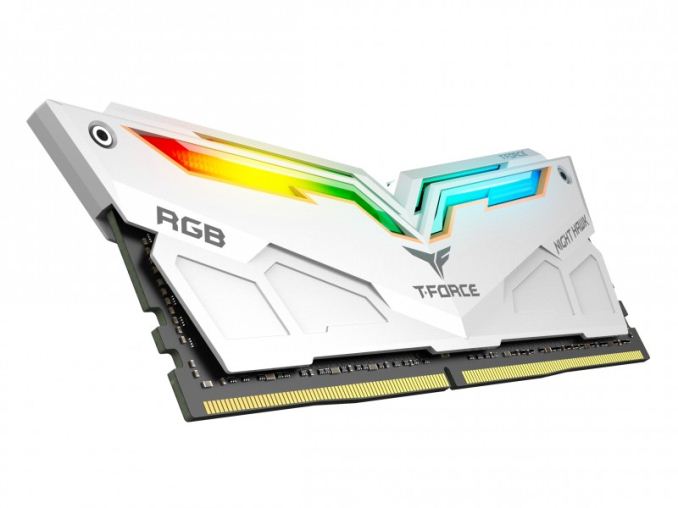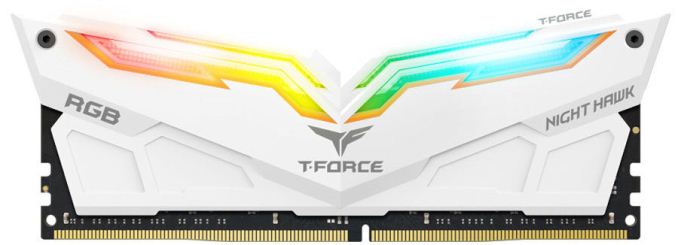Memory Scaling on Ryzen 7 with Team Group's Night Hawk RGB
by Ian Cutress & Gavin Bonshor on September 27, 2017 11:05 AM ESTTeam Group's Night Hawk RGB Memory
16GB of DDR4-3000 CL16 (TF2D416G3000HC16CDC01)
For our testing, Team Group provided us with a dual channel kit from its T-Force Night Hawk RGB range. This is a 2x8 GB kit rated at DDR4-3000 with latency timings of 16-18-18-38. The T-Force Night Hawk DDR4-3000’s are a fairly middle of the road (spec wise) dual channel offering when compared to some of the high-end kits, but the Night Hawk kit comes aims at a much more reasonable balance of price point and performance. With the high-performance kits, the price is paid on the way the memory is binned - with kits like the Night Hawk RGB, there is a small 'RGB tax' over non-RGB mono-color variants, which usually comes in at around $5-$10 depending on the manufacturer. The RGB element is purely for aesthetics, so while on paper and financially it makes less sense to opt for the RGB option over the mono-colored version, our discussions with vendors gave an insight into this market. As far as we were told, RGB sales are growing faster than anyone ever expected - system design customisability is becoming an important consideration of a PC build.
For the memory itself, Team Group has gone with a rather eccentric hawk inspired heatsink design as the brand. The modules end up 1.73”/44mm in height, so for context, the Noctua NH-D14 CPU cooler has a clearance for memory of up to 45mm, so this kit should just about fit.
Under the heat sinks, Team Group has opted to use single sided Samsung B-die ICs. These memory ICs are highly favoured by extreme overclockers for their potential overclockability and frequency scaling, as well as the ability to really tighten the latencies; at very high frequencies and tight latencies, some of the more synthetic tests that competitive overclockers love make a difference, and memory manufacturers use that as a marketing tool when it comes to B-die. That being said, despite sending us a memory kit using B-die, Team Group did say however that in future it could change the ICs in the kits depending on market pricing and availability of such modules. This is disappointing, but not completely unexpected as other companies also do this. Our normal policy applies when this is the case: if this were to occur, we would want the model number would change to reflect this. There are attempts online by competitive overclockers to identify which memory modules use certain ICs, so if one model number had several IC versions, it would be very confusing to organise.

The Team Group T-Force Night Hawk RGB DDR4-3000 kit comes with a global lifetime guarantee in the US, and supports RGB LED customisation. This particular kit is synchronizable with ASUS motherboards via ASUS Aura Sync. The purpose of platforms like Aura Sync is to allow users looking to colour match their existing products through products such as peripherals, motherboards, VGA and even RGB LED strips such as BitFenix’s Alchemy range and virtually all of Cablemod’s current line-up.











65 Comments
View All Comments
Drumsticks - Wednesday, September 27, 2017 - link
Interesting findings. I've seen Ryzen hailed on other simple forums like Reddit as having great scaling. There's definitely some at play, but not as much as I'd have thought.How does this compare to Intel? Are there any plans to do an Intel version of this article?
ScottSoapbox - Thursday, September 28, 2017 - link
2nd!I'd like to see how much quad channel helps the (low end) X299 vs the dual channel Z370. With overlapping CPUs in that space it could be really interesting.
blzd - Thursday, September 28, 2017 - link
Yes please compare to Intel memory gains, would be very interested to see if it sees less/more boost from higher speed memory.Great article BTW.
jospoortvliet - Saturday, September 30, 2017 - link
While I wouldn't mind another test there have been plenty over the last year's as the authors also pointed out in the opening of the article and the results were simple - it makes barely any difference, far less even than for Ryzen..vodka - Wednesday, September 27, 2017 - link
Default subtimings in Ryzen are horribly loose, and there's lots of performance left on the table apart from IF scaling through memory frequency and more bandwidth. You've got B-die here, you could try these, thanks to The Stilt:http://www.overclock.net/t/1624603/rog-crosshair-v...
This has also been explored by AMD in one of their community updates, at least in games:
https://community.amd.com/community/gaming/blog/20...
Ian Cutress - Wednesday, September 27, 2017 - link
The sub-timings are determined by the memory kit at hand, and how aggressive the DRAM module manufacturer wants to make their ICs. So when you say 'default subtimings on Ryzen are horribly loose', that doesn't make sense: it's determined by the DRAM here. Sure there are adjustments that could be made to the kit. We'll be tackling sub-timings in a later piece, as I wanted Gavin's first analysis piece for us to a reasonable task but not totally off the deep end (as our Haswell scaling piece showed, 26 different DRAM/CL combinations can take upwards of a month of testing). I'll be working with Gavin next week, when I'm back in the office from an industry event the other side of the world and I'm not chasing my own deadlines, to pull percentile data from his numbers and bringing parity with some of our other testing.xTRICKYxx - Wednesday, September 27, 2017 - link
.vodka is right. Please investigate!looncraz - Wednesday, September 27, 2017 - link
AMD sets its own subtimings as memory kits were designed for Intel's IMC and the subtimings are set accordingly.The default subtimings are VERY loose... sometimes so loose as to even be unstable.
.vodka - Wednesday, September 27, 2017 - link
Sadly, that's the situation right now. We'll see if the upcoming AGESA 1.0.0.7 does anything to get things running better at default settings.This article as is, isn't showing the entire picture.
notashill - Wednesday, September 27, 2017 - link
There's a new AGESA 1.0.0.6b but AMD has said very little about what changed in it.